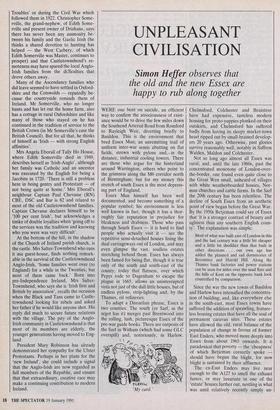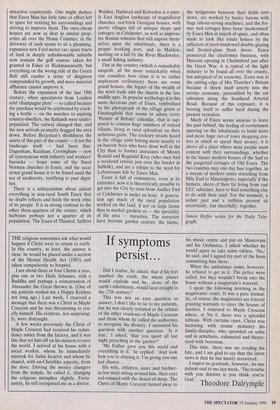UNPLEASANT CIVILISATION
Simon Helfer observes that the old and the new Essex are happy to rub along together
WERE one bent on suicide, an efficient way to confirm the atrociousness of exist- ance would be to drive the few miles down the Southend Arterial Road from Romford to Rayleigh Weir, diverting briefly to Basildon. This is the environment that bred Essex Man; an unremitting trail of uniform inter-war semis abutting on flat fields, strewn with pylons and,. in the distance, industrial cooling towers. There are those who argue for the hinterland around Warrington, others who point to the grimness along the M6 corridor north of Birmingham; but for my money this stretch of south Essex is the most depress- ing part of England.
Essex Man himself has been well documented, and become something of a popular symbol; his environment is less well known in fact, though it has a thor- oughly fair reputation in prejudice for bleakness and drabness. Those who pass through South Essex — it is hard to find people who actually visit it — see the repetitive semi-detached houses lining the dual carriageways out of London, and may even glimpse the vast, soulless estates stretching behind them. Essex has always been famed for being flat, though it is true only of the south and south-east of the county; today that flatness, over which Pepys rode to Dagenham to escape the plague in 1665, allows an uninterrupted vista not just of the dull little houses, but of endless pylons, strip-lighting and, by the Thames, oil refineries.
To adapt a Disraelian phrase, Essex is two counties. The south (or Sarf, as the argot has it) merges past Brentwood into the rolling, lush, picturesque Essex of the pre-war guide books. There are outposts of the Sarf in Witham (which had some GLC overspill) and, notoriously, in Harlow. Chelmsford, Colchester and Braintree have had expensive, tasteless modern housing for proto-yuppies plonked on their outskirts, and Chelmsford has suffered badly from having its sleepy market-town heart ripped out by small-brained develop- ers 20 years ago. Otherwise, past glories survive reasonably well, notably in Saffron Walden, Maldon and Colchester.
Not so long ago almost all Essex was rural; and, until the late 1960s, past the concentrated monotony of London-over- the-border, one found even quite close to the Great Wen small, unheard-of villages with white weatherboarded houses, Nor- man churches and cattle farms. In the Sarf the 20th century has been relentless. The decline of South Essex from an aesthetic point of view began before the Great War. By the 1950s Betjeman could say of Essex that it is a stronger contrast of beauty and ugliness than any southern English coun- ty'. The explanation was simple:
Most of what was built east of London in this and the last century was a little bit cheaper and a little bit shoddier than that built in other directions . . . . our own age has added the planned and sad dormitories of Becontree and Harold Hill. Along the Thames bank factories and power stations can be seen for miles over the mud flats and the hills of Kent on the opposite bank look countrified by comparison.
Since the war the new towns of Basildon and Harlow have intensified the concentra- tion of building; and, like everywhere else in the south-east, most Essex towns have suffered the addition of sprawling, feature- less housing estates that have all the soul of permanent caravan sites. These estates have allowed the old, rural balance of the population of change in favour of former East Enders, who moved more deeply into Essex from about 1965 onwards. It is paradoxical that poverty — the 'cheapness' of which Betjeman correctly spoke should have begun the blight, for now blight is sustained by their affluence.
The ex-East Enders may live near enough to the A127 to smell the exhaust fumes; or may luxuriate in one of the `estate' houses further out, nestling in what was until relatively recently simply un- attractive countryside. One might deduce that Essex Man has little time or effort left to spare for noticing his surroundings and striving to improve them. The once-cheap houses are now as dear as similar prop- erties all over the Home Counties; in the driveway of each seems to sit a gleaming, expensive new Ford motor car; spare tracts of land in deeply unfashionable suburbs now contain the golf courses taken for granted in Esher or Rickmansworth; but everything on the wrong side of the Green Belt still exudes a sense of dinginess compounded by growth, and mere material affluence cannot improve it.
Before the expansion of the late 19th century, when speculators from London sold 'champagne plots' — so called because the purchase would be celebrated by crack- ing a bottle — on the marshes to aspiring country-dwellers, the flatlands were under- populated. The railway changed that, and the new arrivals promptly dragged the area down. Before Betjeman's shoddiness the assets of this part of the county — if not the landscape itself — had been fine. Dagenham, Rainham, Corringham — now all synonymous with industry and workers' barracks — boast some of the finest Norman churches in Essex, and the occa- sional grand house is to be found amid the sea of mediocrity, testifying to past digni- ties.
There is a utilitarianism about almost everything in non-rural South Essex that no doubt reflects and feeds the work ethic of its people. It is in strong contrast to the other three-quarters of the county, which harbours perhaps not a quarter of its population. The Essex of Thaxted, Saffron Walden, Halstead and Kelvedon is a pure- ly East Anglian landscape of magnificent churches, red brick Georgian houses, with pretty villages full of antique shops and cottages; in Colchester, as well as impress- ive Roman remains that still impose them- selves upon the inhabitants, there is a proper working port, and in Maldon, nestling on a hill by the River Blackwater, a small fishing industry.
Out in the country (which is remarkably unspoilt, all the more remarkably when one considers how close it is to rather unpleasant civilisation) there are some grand houses, the legacy of the wealth of the wool trade and the church in the late middle ages. In popular mythology it is this more decorous part of Essex, symbolised by the photograph of the village green at Finchingfield that seems to adorn every `Picture of Britain' calendar, that is sup- posed to contain huge numbers of retired villains, living in rural splendour on their nefarious gains. The cockney strains heard in the village pubs belong more usually to ex-barrow boys who have done well in the City than to former associates of Messrs Ronald and Reginald Kray (who once had a weekend retreat just over the border in Suffolk), and are a tribute to the need for Lebensraum felt by Essex Man.
Essex is full of commuters, even at its extremes, now it is theoretically possible to get into the City by train from Audley End or Colchester in under an hour. A genera- tion ago much of the rural population worked on the land, if not on large farms then in market gardens or — the speciality of the area — nurseries. The nurseries have become garden centres; the farms, the hedgerows between their fields torn down, are worked by barley barons with huge labour-saving machines; and the for- mer tied cottages have been 'modernised' by Essex Men in search of space, and often made to look like estate houses by the infliction of steel-windowed double-glazing and frosted-glass front doors. Essex pioneered the electronics business, with Marconi opening in Chelmsford just after the Great War; it is typical of the light industry to be found all over the county, but untypical of its economy. Essex was at the cutting edge of Mrs Thatcher's Britain because it threw itself utterly into the service economy, personified by the car salesmen along the Southend Arterial Road. Because of this exposure, it is bracing itself to suffer hard during the present recession.
Much of Essex seems anxious to leave the past behind, the feeling of rootlessness spurring on the inhabitants to build more and more huge out-of town shopping cen- tres in which to spend their money; it is above all a place where most people seem content with their surroundings, whether in the luxury modern houses of the Sarf or the pargetted cottages of Old Essex. The two counties may one day fuse together, in a stream of modern semis stretching from Mile End to Manningtree; especially if the farmers, shorn of their fat living from vast EEC subsidies, have to find something else to do with their land. For the moment, a sedate past and a ruthless present sit uncertainly, but cheerfully, together.
Simon Heifer writes for the Daily Tele- graph.



















































 Previous page
Previous page